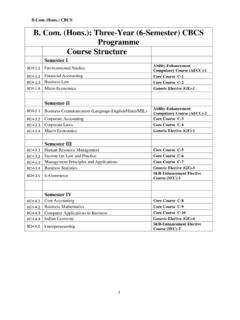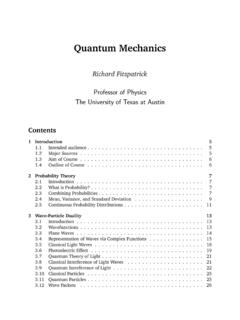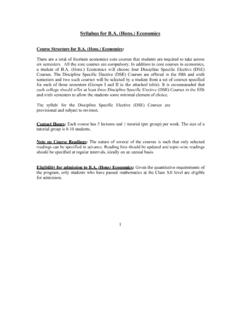Transcription of COURSE FILE - Geethanjali Group of Institutions
1 SATELLITE COMMUNICATION. COURSE FILE. Contents COURSE file Contents: 1. Cover Page 2. Syllabus copy 3. Vision of the Department 4. Mission of the Department 5. PEOs and POs 6. COURSE objectives and outcomes 7. Instructional Learning Outcomes 8. Prerequisites, if any 9. Brief note on the importance of the COURSE and how it fits into the curriculum mapping with PEOs and POs Time Table Time Table Plan with dates and closure report notes topics Question papers of previous years Bank topics wise Quiz Questions problems gaps ,if any , Journals, websites and E-links Control Sheets List measurement sheets a) COURSE end survey b) Teaching evaluation 26. Group -Wise students list for discussion topics 1.
2 COVER PAGE. Geethanjali COLLEGE OF ENGINEERING AND TECHNOLOGY. DEPARTMENT OF Electronics and Communication Engineering (Name of the Subject / Lab COURSE ) : Satellite Communications (JNTU CODE - ) Programme : UG. Branch: ECE Version No : 02. Year: IVYear ECE (C ) Document Number: GCET/ECE//. Semester: II No. of pages : Classification status (Unrestricted / Restricted ). Distribution List : Prepared by : 1) Name : MD TOUSEEF SUMER. 1) Name : 2) Sign : 2) Sign : 3) Design : 3) Design : Verified by : 1)4)Name Date :: 11/11/13 4) Date * For: Only. 2) Sign : 1) Name : 3) Design : 2) Sign : 4) Date : 3) Design : 4) Date : Approved by : (HOD ) 1) Name : ,SRI HARI.
3 2) Sign : 3) Date : 2. SYLLABUS. Geethanjali COLLEGE OF ENGINEERING & TECHNOLOGY. Cheeryal, Keesara (M), DEPARTMENT OF ECE. SYLLABUS. JAWAHARLAL NEHRU TECHNOLOGICAL UNIVERSITY HYDERABAD. IV Year ECE. I-Sem TPC. 4+1* 0 4. SATELLITE COMMUNICATIONS. (ELECTIVE II). UNIT I. INTRODUCTION [2] : Origin of Satellite Communications, Historical Back-ground, Basic Concepts of Satellite Communications, Frequency allocations for Satellite Services, Applications, Future Trends of Satellite Communications. UNIT II. ORBITAL MECHANICS AND LAUNCHERS [1]: Orbital Mechanics, Look Angle determination, Orbital perturbations, Orbit determination, launches and launch vehicles, Orbital effects in communication systems performance.
4 UNIT III. SATELLITE SUBSYSTEMS[1] : Attitude and orbit control system, telemetry, tracking, Command and monitoring, power systems, communication subsystems, Satellite antenna Equipment reliability and Space qualification. UNIT IV. SATELLITE LINK DESIGN [1] : Basic transmission theory, system noise temperature and G/T ratio, Design of down links, up link design, Design of satellite links for specified C/N, System design example. UNIT V. MULTIPLE ACCESS [1][2] : Frequency division multiple access (FDMA) Intermodulation, Calculation of C/N. Time division Multiple Access (TDMA) Frame structure, Examples. Satellite Switched TDMA Onboard processing, DAMA, Code Division Multiple access (CDMA),Spread spectrum transmission and reception.
5 UNIT VI. EARTH STATION TECHNOLOGY [3]: Introduction, Transmitters, Receivers, Antennas, Tracking systems, Terrestrial interface, Primary power test methods. UNIT VII. LOW EARTH ORBIT AND GEO-STATIONARY SATELLITE SYSTEMS[1] : Orbit consideration, coverage and frequency considerations, Delay & Throughput considerations, System considerations, Operational NGSO constellation Designs UNIT VIII. SATELLITE NAVIGATION & THE GLOBAL POSITIONING SYSTEM [1] : Radio and Satellite Navigation, GPS Position Location principles , GPS Receivers and codes, Satellite signal acquisition, GPS Navigation Message, GPS signal levels, GPS receiver operation, GPS C/A code accuracy, Differential GPS.
6 TEXT BOOKS: 1. Satellite Communications Timothy Pratt, Charles Bostian and Jeremy Allnutt, WSE, Wiley Publications, 2nd Edition, 2003. 2. Satellite Communications Engineering Wilbur L. Pritchard, Robert A Nelson and Henri , 2nd Edition, Pearson Publications, 2003. REFERENCES: 1. Satellite Communications: Design principles M. Richharia, BS Publications, 2nd Edition, 2003. 2. Satellite Communication - Agarwal, Khanna Publications, 5th Ed. 3. Fundamentals of Satellite Communications Raja Rao, PHI, 2004. 4. Satellite Communications Dennis Roddy, mcgraw hill , 2nd Edition, 1996. OF THE DEPARTMENT. To impart quality technical education in Electronics and Communication Engineering emphasizing analysis, design/synthesis and evaluation of hardware/embedded software using various Electronic Design Automation (EDA) tools with accent on creativity, innovation and research thereby producing competent engineers who can meet global challenges with societal commitment.
7 3. MISSION OF THE DEPARTMENT. i. To impart quality education in fundamentals of basic sciences, mathematics , electronics and communication engineering through innovative teaching-learning processes. ii. To facilitate Graduates define, design, and solve engineering problems in the field of Electronics and Communication Engineering using various Electronic Design Automation (EDA) tools. iii. To encourage research culture among faculty and students thereby facilitating them to be creative and innovative through constant interaction with R & D organizations and Industry. iv. To inculcate teamwork, imbibe leadership qualities, professional ethics and social responsibilities in students and faculty.
8 4. PEOS AND POS. Program Educational Objectives of B. Tech (ECE) Program : I. To prepare students with excellent comprehension of basic sciences, mathematics and engineering subjects facilitating them to gain employment or pursue postgraduate studies with an appreciation for lifelong learning. II. To train students with problem solving capabilities such as analysis and design with adequate practical skills wherein they demonstrate creativity and innovation that would enable them to develop state of the art equipment and technologies of multidisciplinary nature for societal development. III. To inculcate positive attitude, professional ethics, effective communication and interpersonal skills which would facilitate them to succeed in the chosen profession exhibiting creativity and innovation through research and development both as team member and as well as leader.
9 Program Outcomes of ECE Program: 1. An ability to apply knowledge of mathematics , Science, and Engineering to solve complex engineering problems of Electronics and Communication Engineering systems. 2. An ability to model, simulate and design Electronics and Communication Engineering systems, conduct experiments, as well as analyze and interpret data and prepare a report with conclusions. 3. An ability to design an Electronics and Communication Engineering system, component, or process to meet desired needs within the realistic constraints such as economic, environmental, social, political, ethical, health and safety, manufacturability and sustainability.
10 4. An ability to function on multidisciplinary teams involving interpersonal skills. 5. An ability to identify, formulate and solve engineering problems of multidisciplinary nature. 6. An understanding of professional and ethical responsibilities involved in the practice of Electronics and Communication Engineering profession. 7. An ability to communicate effectively with a range of audience on complex engineering problems of multidisciplinary nature both in oral and written form. 8. The broad education necessary to understand the impact of engineering solutions in a global, economic, environmental and societal context. 9. Recognition of the need for, and an ability to engage in life -long learning and acquire the capability for the same.













